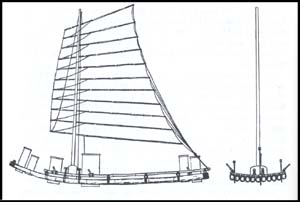|

Fleet-Tribes
The basic cultural unit for the Moa-Ruaki is the "fleet-tribe", comprised of many families travelling together on a variety of ships (see sidebar). The largest Moa-Ruaki travelling ships are vast catamarans called pahu, capable of holding up to eighty people plus provisions for several months. Smaller dugout outrigger canoes accompany the pahu as support ships, landing craft and as war canoes.
The Moa-Ruaki are sort of "sea gypsies", moving from island to island. Some tribe-fleets follow a set pattern, others go where the winds (and prophetic dreams) take them. However, most come ashore at some point. There are a few fleet-tribes, considered holy by the other Moa-Ruaki, who never set foot on land. Amongst the majority of tribes, it is only the chief and kahunas who cannot set foot on land. Many Moa-Ruaki make use of rope-soled shoes when they come ashore, however, to avoid polluting themselves.
They are quite friendly to all outsiders who treat them with respect, and will trade coral, pearls or sponges in exchange for metal goods and other items that they can't manufacture. Moa-Ruaki are famed divers and renowned for being able to hold their breath for several minutes.
Families are quite loosely defined, since the Moa-Ruaki have few sexual taboos. Marriages are informal affairs and sex is often treated on the same level as a handshake. Casual touching of another's genitals is seen as no more intimate than other cultures would see a pat on the back. Homosexuality is accepted, and even encouraged amongst groups of young men or women who for some reason work together a lot, such as a warrior's circle. Sometimes the Moa-Ruaki use sex as a means to seal a deal. The worst sexual taboo is that against having intercourse with a woman during menstruation. This act can be punishable by death, since in the eyes of the Moa-Ruaki the person responsible has come into contact with dangerous energy - the life giving potency of the woman is discharged and thus becomes death-bringing energy instead.
Traditionally, Moa-Ruaki use virtually no metal - their boats are remarkably almost entirely wood and hide. Sails are made from woven rushes. Certain types of kelp are rendered down to produce adhesive. Trade with the Merchant's League, however, has led to a rise in metal use amongst all but the most isolated or conservative fleet-tribes.

Diagram of a kawa-ri family boat
The most important member of the tribe is the chief, who is seen as the centre of the fleet. The method of choosing a chief varies from tribe to tribe - election, contests of skill or inheritance are all used. Almost as important as the chief, and more vital to the fleet-tribe's survival, are the navigators and the magicians (kahunas). Methods of navigation include reading the stars, currents, colour of the water, wave patterns, wind direction and underwater lights (said to be the work of spirits, but may be caused by submarine vulcanism). Most Moa-Ruaki have some skill at interpreting these phenomenon, but navigators have an almost supernatural feel for them.
Food
The diet of the Moa-Ruaki can be pretty monotonous, but provides an acceptable level of nutrition. Fishing, of course, is the main source of meat, and when near land birds are hunted. In addition, fleet-tribes carry dogs for eating. The dogs are fed solely on a diet of fruit to make their flesh succulent and sweet.
Fruit, vegetables and grain are grown in ceramic pots on "garden rafts" (Papa-Ri, see sidebar). Staples are provided by breadfruit, taro, sorghum and lemoko beans, a dark green pulse. These staples are supplemented by coconuts, tree fruits and kelp. The growing and harvesting of those goods are up to individuals or families more than the tribe as a whole. Recycled waste is used as fertiliser. During harsh weather, the crops are broken up into individual crates and pots, then spread among the other ships. The travels of the Moa-Ruaki have propagated many of these species throughout the world.
War
Weapons are mainly wood and stone, with deadly hardwood clubs, bolas and spears. Some obsidian is used, and metal and sea-bone are becoming common due to trade with other species. Shark's teeth are sometimes set into wooden clubs to increase their efficiency. The Moa-Ruaki do not traditionally use armour, but protective enchantments are not unknown.
Moa-Ruaki prefer to trade and talk rather than fight to settle disagreements, but sometimes prophetic dreams sent to the kahuna mean that a war is required by the gods. Generally fights last until the objectives are achieved and then everyone is friends again (not everyone is always happy with this, of course).
Hostage-taking is a common (and expected) feature of Moa-Ruaki battles. Kahunas and navigators are supposed to be exempt from hostage-taking as they are too essential to the tribe. You can tell who they are by their tattoos. Anyone else, even the chief, is allowed to be taken. The idea is to give yourself a bargaining chip at the end of the fight, but sometimes "bandit" groups steal young men and women to boost their tribal numbers. Gift-giving after the fight is also a common practise, with the winner expected to give up more.
In fights against outsiders, the rules of war are ignored. Fortunately these clashes are rare, but the violation of a sacred island always calls for a violent response.

|
Moa Ruaki Overview
Mythology and Magic
Necklace of Plenty
Corapeti
Gloppies
|
